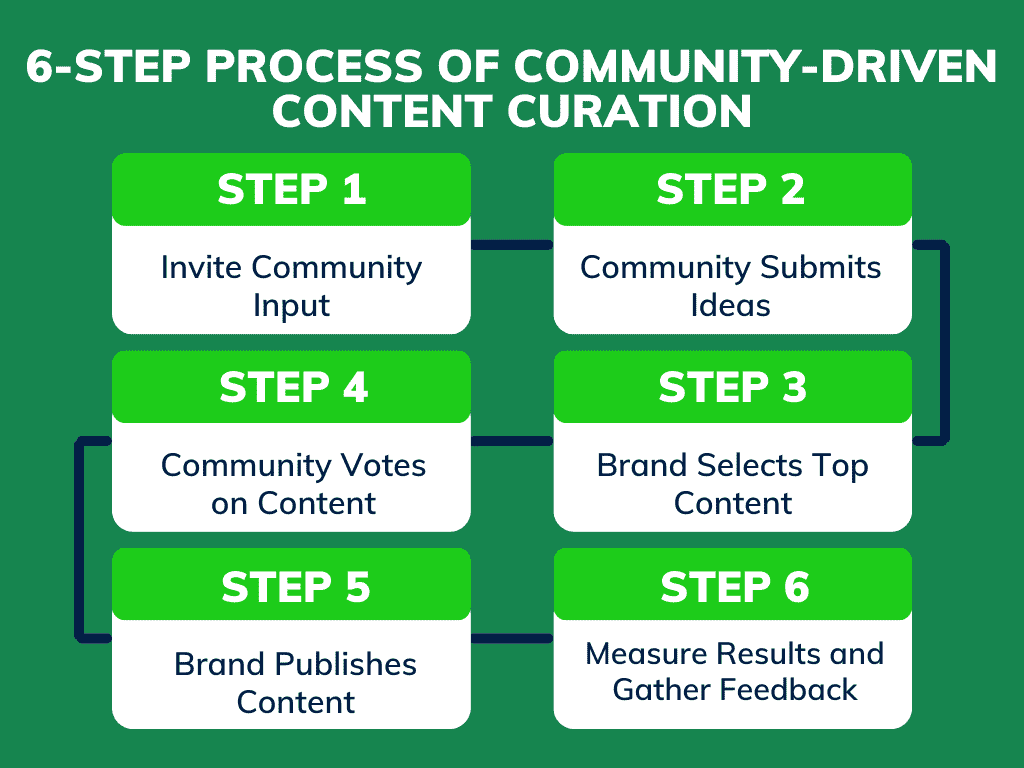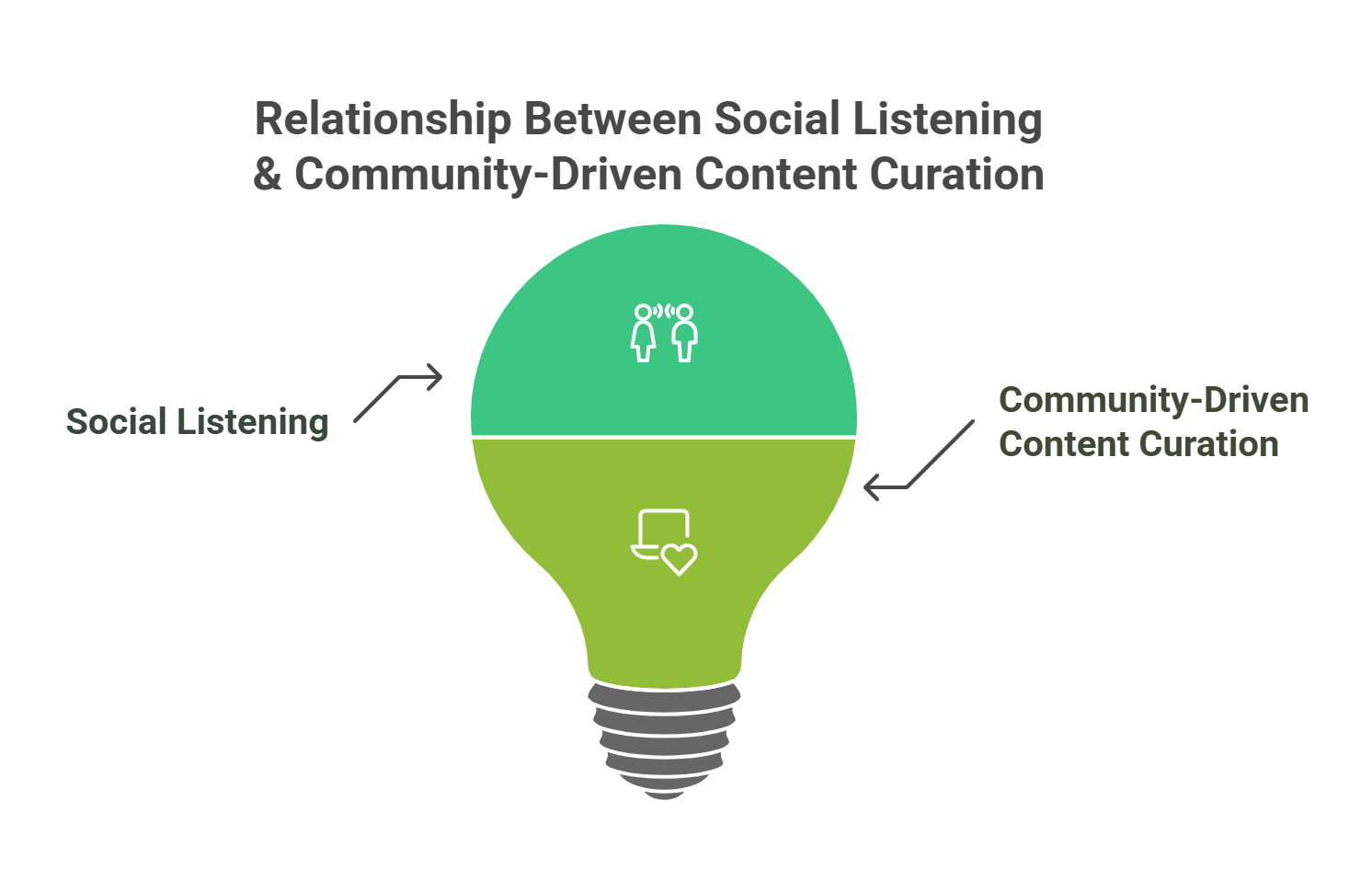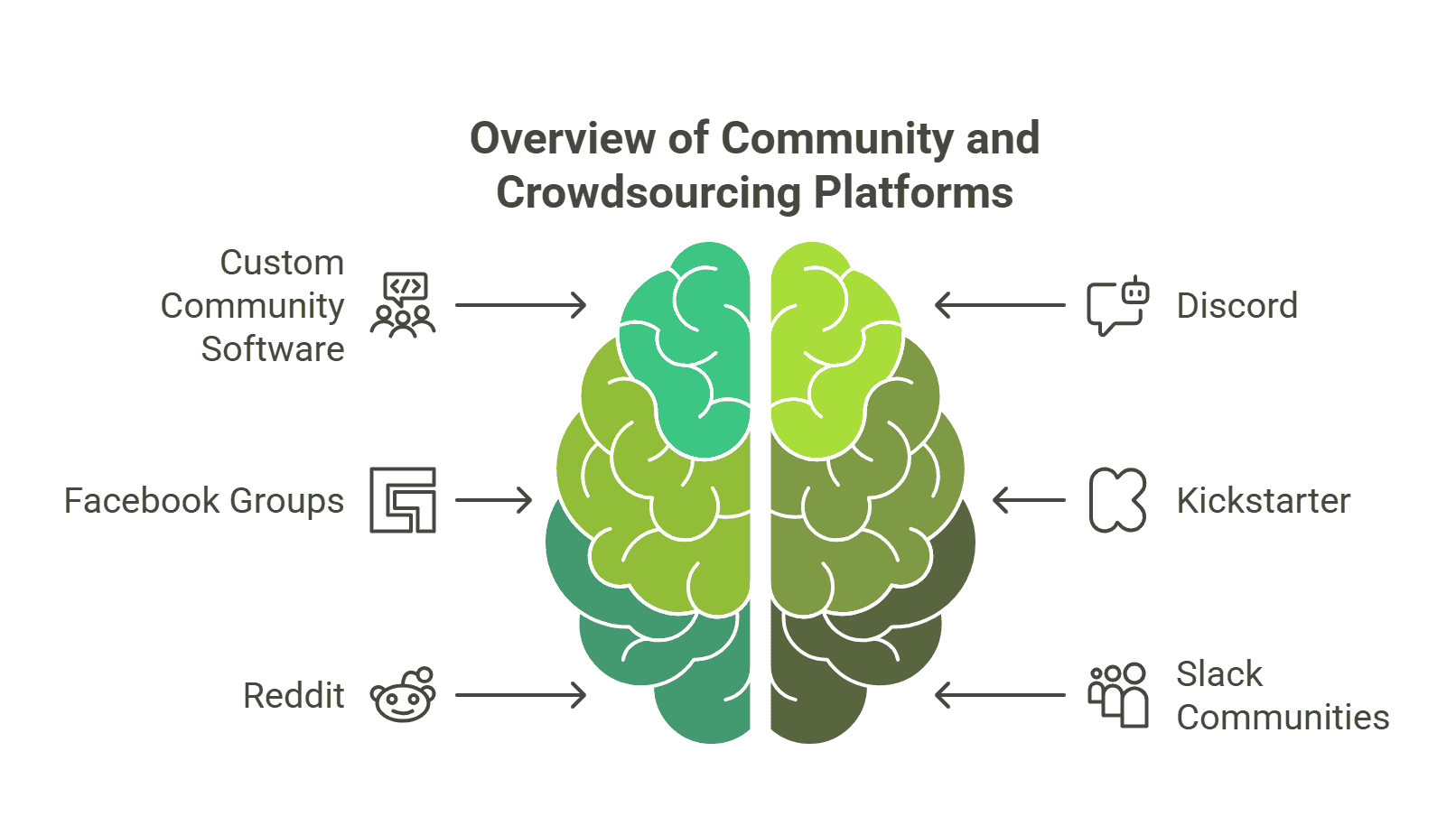How to Implement Community-Driven Curation
Are you using Community-Driven Content Curation?
Jump Ahead to Learn:
To busy to read? To busy to read? Listen to the podcast summary. 3 minutes
Introduction to Community Driven Content Curation
Community-driven content curation is a growing trend that puts your target audience at the heart of your marketing process. Instead of relying only on your brand’s marketing team, you encourage your community (your customers, supporters, or potential customers) to shape the content you produce and promote. This should be a core aspect of your content marketing and larger digital marketing strategy.
This approach is especially helpful for businesses facing rapid changes in consumer preferences, where top-down methods can feel slow or disconnected.
Brands often assume they know what customers want. While research and development can get you close, real consumer needs can shift faster than any internal process can handle. Community-driven curated content makes it possible to adapt in near real time, allowing companies to keep pace with market changes, while also saving time.
You still stay true to your brand’s mission, but now you have up-to-date input from the very people you’re trying to serve. This can reduce guesswork and help you create content that resonates with your audience’s evolving tastes.
What is Community-Driven Content Curation
Core Meaning
Community-driven content curation means letting the community actively choose and organize the content you share. Instead of a small team deciding what’s relevant, community members vote, comment, or provide direct feedback.
This ensures the content truly reflects what your audience cares about. For example, a brand might open a dedicated forum, chat group, or social feed where members submit ideas. Those ideas can then be liked or voted on by others. The highest-rated topics become key pieces of your content strategy.
In many ways, this is like crowdsourcing, but with a stronger emphasis on conversation. According to insights from the Social+ blog, online communities that handle 30–50% of a brand’s content creation see higher engagement, loyalty, and even revenue growth. With these numbers in mind, it’s no surprise that more companies are tapping into community involvement.
Key Principles
Collective Decision-Making
The community discusses, votes on, and highlights content. This approach ensures that what gets produced matches real user needs, rather than guesses.
Niche Focus
Many communities form around specific interests, from eco-friendly products to gaming. This “niche approach” allows businesses to find audiences deeply passionate about a single topic, increasing engagement.
Ongoing Feedback Loop
Real-time user input shapes future content. If members don’t like an idea, they let you know right away, so you can adapt and avoid wasting resources.
Real Brand Example
Mini-Case Study: Consider Patagonia, a well-known outdoor clothing brand. They involve customers in telling stories about product repairs and adventures through their “Worn Wear” program.
The brand’s community supplies much of the material, including images and videos of their gear in action. As a result, the brand’s marketing feels more honest and relevant. Customers see proof that Patagonia’s products are durable and worth discussing.
Social Listening and Community-Driven Content Curation: How They're Connected
Social listening and community-driven content curation work closely together to help brands understand and engage their audience better. Social listening involves tracking conversations across social media platforms to learn what your customers are saying about your brand, competitors, or industry. It's about actively paying attention to the voices of your customers online.
Community-driven content curation takes social listening a step further. Instead of just monitoring conversations, you're empowering your audience to become active contributors to your content strategy. Through social listening, you discover what your audience cares about. With community-driven curation, you invite them into your process, allowing their insights and opinions to shape your future content directly. Which in turn helps build relationships.
For example, if social listening reveals customers frequently asking questions about sustainability practices, you might create a community-curated forum or group specifically around sustainability. Here, your customers can directly suggest, vote on, and influence the creation of new content, campaigns, or even products.
Brands like Nike and Sephora regularly use social listening tools to capture customer feedback and then channel that insight into their community-driven platforms to create relevant content. Nike’s Design & Grind Challenge lets people submit ideas to compete for $30,000 USD.
By blending social listening with community-driven curation, these brands ensure they’re not only hearing their customers but actively involving them in shaping the brand experience.
In short, social listening helps you identify the conversations that matter. Community-driven curation turns those insights into authentic engagement and loyalty.
Traditional Top-Down Content Strategies
Definition and Background
A traditional top-down content strategy places most decisions in the hands of a central figure or a small marketing team. This was very common in older media, where editors and executives had full control over what was published.
Even today, many big companies still use this system because it offers a clear chain of command. It’s straightforward. Brand leaders pick a topic, the marketing team produces it, and the audience receives it.
Limitations
Disconnect From Audience Interests
Audience preferences may have shifted by the time the final content is approved. That gap can lead to less engagement.
Slower Response to Market Changes
Top-down approaches often take weeks or months to develop new content. For example, a campaign might need multiple approval rounds, causing delays.
Why It’s Still Used
For large organizations, top-down methods are familiar and feel “safe.” Plus, regulated industries, such as pharmaceuticals, finance or government, need strict oversight to ensure content follows compliance rules.
However, even regulated industries are starting to look for ways to include customer input and content creators without violating regulations.
Community-Driven Marketing vs. Top-Down: Key Differences
Level of Audience Involvement
Community-Driven: High. You invite your audience to share ideas and vote on them. This can make them feel valued and more invested in your brand.
Top-Down: Lower. The audience mostly consumes what you produce, with limited input.
Type of Content Flow
Community-Driven: Content is more flexible, shaped by ongoing conversations.
Top-Down: Topics are often decided months in advance, which can work well for predictable schedules but may seem less responsive to news and trends.
Speed of Adaptation
Community-Driven: Quick pivots based on crowd sentiment. If your community signals something is off, you can fix it fast.
Top-Down: Often requires departmental or management approval, slowing down the process.
Pros and Cons
Pros (Community-Driven)
Authentic Engagement and Trust: Content feels more genuine because it comes from real people.
Continuous Supply of Ideas: Your users keep suggesting new topics, reducing creative bottlenecks.
Deeper Connection with Loyal Followers: Engagement isn’t just about views; it’s about long-term relationships.
Cons (Community-Driven)
Active Moderation Required: Someone must enforce guidelines and remove spam or inappropriate posts.
Consistent Brand Messaging Can Be Challenging: Letting people speak freely is great for authenticity, but it requires careful oversight so the conversation stays aligned with brand values.
Pros (Top-Down)
Clear Brand Voice and Control: Management can carefully shape every message, ensuring consistency.
Streamlined Planning: It’s easier to create a long-term editorial calendar.
Cons (Top-Down)
Risk of Outdated Content: Shifts in consumer tastes can leave planned campaigns feeling irrelevant.
Lower Engagement: People sense they’re being “talked at” rather than listened to.
How to Implement Community-Driven Content Curation
Below are practical steps you can follow if you decide to add this strategy to your marketing plan.
Set Clear Objectives
Identify your goals (increasing brand loyalty, capturing product feedback, boosting user engagement).
Choose metrics to track these goals (community growth, number of user-created posts, average engagement).
Choose the Right Platform
Community Forums: Platforms like Reddit or specialized forums work well if your brand has a strong community presence.
Real-Time Interaction: Discord is popular with gaming and tech audiences because it offers live chat and voice channels.
Community Software: Some businesses use specialized platforms that integrate metrics, moderation, and user profiles all in one place.
Invite and Onboard Members
Offer perks to early adopters (discounts, exclusive content) to encourage sign-ups.
Make your community simple to join. Fewer steps mean less friction.
Establish Guidelines and Moderation
Provide clear rules for respectful interaction.
Assign moderators or set up a peer-reviewed system. This can range from upvotes and downvotes to formal complaint mechanisms.
Encourage Ongoing Engagement
Post regular prompts or contests. For example, a weekly “Ask Me Anything” session can spark interest.
Highlight top contributors in newsletters or on your main website.
Measure and Adjust
Track engagement metrics and look for trends.
Adapt your content or community rules based on what users say or do.
Real Brand Examples
Open-Source Projects
Look at the open-source software community, such as Linux. Developers around the world contribute code, documentation, and support. This results in a constantly improving product without a single “official” marketing plan. It’s a true example of community curation: user discussions shape new features, bug fixes, and tutorials.
Niche Forums
Major brands like Nike have turned to forums or specialized groups to hear from their most passionate customers. Nike’s SNKRS app, for instance, highlights user-generated content on new sneaker drops, creating hype and loyalty among fans.
Crowdsourcing and Community-Based Platforms
Custom Community Software (Mighty Networks, Tribe, etc.): These specialized platforms help brands host fully customized communities, seamlessly integrating content sharing, discussions, and analytics in one place.
Discord: Known for gaming, but many tech and lifestyle brands have begun using it to gather insights and share news.
Facebook Groups: Brands create communities to engage directly with followers, answer questions, and encourage conversation around shared interests.
Kickstarter: Entrepreneurs pitch ideas, and backers (the community) decide what gets funded.
Reddit: Communities called subreddits focus on specific topics. Some brands host AMAs (Ask Me Anything) or discussions to learn what customers want.
Slack Communities: Businesses use Slack to build professional groups where customers and experts exchange ideas, offer feedback, and collaborate.
Potential ROI and Benefits
Boosted Engagement
When your community contributes to content, they’re more invested, leading to higher shares, comments, and user-generated posts. This can improve your reach on social media. It can also help you on search engines. It will be more authentic to your audience.
Community Loyalty
People who help create something often stick around. They see themselves as a vital part of your brand’s success and return frequently to share content, more ideas, or feedback. In some cases, you might even attract a big thought leader with a big following on their social media accounts.
Agility and Real-Time Insights
Rapid response to changing trends is crucial in today’s market. Community-driven curation offers near-instant feedback loops, so you know quickly when something hits, or misses the mark.
Cost-Effectiveness
If members are providing much of the content, you can reduce how much you pay for in-house creation. According to the Tucson Museum of Art’s Community-Based Curation Toolkit, shifting some resources from production to moderation can reduce marketing costs while boosting authenticity.
Frequently Asked Questions (FAQ)
-
Start small. Host live Q&A sessions, offer incentives for posting, and promote your community on your main website or social media channels. Focus on building trust and showing members you value their input.
-
Set clear, respectful guidelines and rely on moderators. If someone complains about your product or service, address it honestly and see if you can improve. Transparent handling of issues can build trust.
-
Yes, you can use a hybrid model. You might plan some “official” brand content ahead of time while leaving room for community-sourced content. This can offer both consistency and flexibility.
-
While highly regulated sectors might face challenges, it’s still possible to involve user feedback in limited ways. For most industries, especially e-commerce, tech, or consumer goods, community-driven content can be a powerful tool.
-
Look at conversions, retention rates, or the number of user-generated pieces that become part of your official marketing. You can also survey community members to gauge satisfaction and loyalty over time.
Python Code Snippet: Tracking Community Sentiment
Below is a simple Python example showing how you might measure community sentiment based on text feedback:
from textblob import TextBlob
import pandas as pd
def analyze_engagement(comments):
sentiments = []
for comment in comments:
analysis = TextBlob(comment)
sentiments.append(analysis.sentiment.polarity)
return pd.Series(sentiments).mean()
# Example usage:
user_comments = ["Love this new feature!", "UI needs improvement"]
avg_sentiment = analyze_engagement(user_comments)
print(f"Community Sentiment Score: {avg_sentiment:.2f}")By gathering comments from forums, social media, or a Discord channel, you can see if your community’s overall mood is positive, neutral, or negative. This helps you know where to focus improvements.
Conclusion
Community-driven content curation offers a direct line to your customers’ current needs. Rather than guessing how to adapt your message or offerings, you have near real-time data from the very people you want to attract. While you do need moderation and clear rules to keep conversations respectful, this approach can lower your marketing costs, boost loyalty, and keep your brand agile.
If you’re ready to start, consider opening a small pilot community. Whether it’s a subreddit, a channel on Discord, or a private forum, you can invite your most dedicated followers and see what happens when you let them shape your content.
The age of talking “at” customers is ending. Now, it’s time to talk with them and let them talk with each other too.






